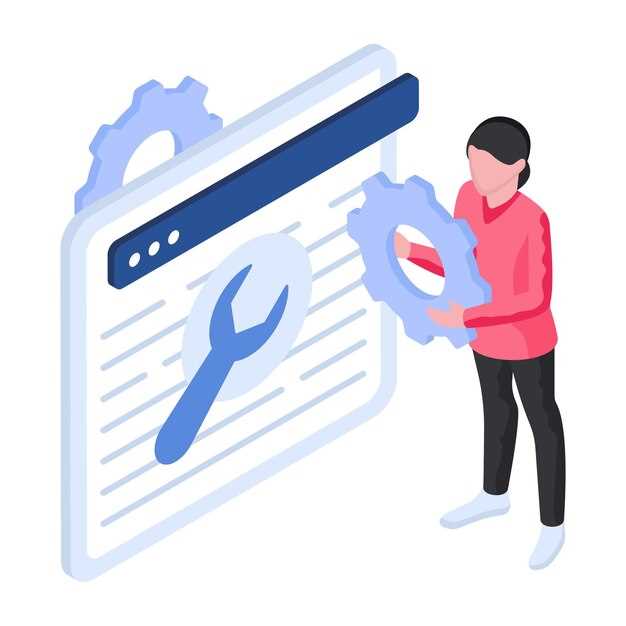Identify the specific problem before you proceed. Break it down into manageable parts. Is your computer unable to connect to the internet? First, check the router. Make sure it’s plugged in and powered on. If the issue persists, move to your computer settings. Ensure Wi‑Fi is enabled and connected to the correct network. This step‑by‑step approach helps pinpoint the exact cause.
Consult the user manual of your device. It contains troubleshooting sections for common problems. Many issues have straightforward solutions often overlooked in frustration. For example, faint lines on a printout could simply mean the printer is low on ink. Addressing this can save time and prevent unnecessary complications. Prioritize simplicity in troubleshooting.
Reach out to online communities for problem‑solving support. Many users have faced similar issues and can offer insights or workarounds. Websites like forums or Q&A platforms are invaluable for discovering tried‑and‑tested solutions from those with firsthand experience. For the latest tips and up‑to‑date guides, you can also visit betwon güncel. Remember, sharing your own solutions enhances communal knowledge and assists others facing similar hurdles. This mutual assistance rounds out a robust approach to troubleshooting.
Handling Account Lock Situations

Contact customer support as your first step. Most service providers have dedicated teams to assist with account lockouts through phone, chat, or email. Before contacting them, have all relevant information ready: account details, identification documents, and any recent transactions if applicable. This will expedite the verification process.
Reset your password using the “Forgot Password” link. Typically, service providers include this option on the login page, which sends a reset link or code via email or SMS to your registered contact information. Check your spam or junk folder if you haven’t received the email.
Keep an eye on any notifications or alerts sent by the service provider. These messages often contain information on why your account was locked and steps to unlock it. If unusual activity prompted the lock, review recent account activities to identify any unauthorized actions.
Enable two-factor authentication (2FA) once access is restored. This adds an extra layer of security, making future lockouts less likely. Choose authentication apps over SMS for enhanced security.
Update your recovery information regularly. Ensure that your email addresses and phone numbers associated with the account are current. This facilitates account recovery if you face another lockout.
Identifying Causes of Account Lock
Review your login credentials carefully to ensure accuracy. Incorrect username or password input is a frequent cause of account lock. Double-check keyboard settings, such as Caps Lock or language changes, which might affect your input.
- Multiple Failed Attempts: Many systems lock accounts after a set number of failed login attempts for security reasons. Monitor unsuccessful login entries and reset your password if needed.
- Password Expiry: Some accounts automatically lock when a password reaches its expiration date without renewal. Check any notifications regarding password status and update it regularly.
- Unusual Activity Detection: Security systems may lock an account if suspicious activity is detected. Review recent account activities, like logins from unfamiliar locations or devices, and follow the recommended security checks.
- Policy Violations: Ensure compliance with account usage policies. Accounts may be locked due to violations such as sharing credentials or accessing restricted content.
- Two-Factor Authentication (2FA) Issues: If enabled, ensure you have access to the authentication method linked to your account. Issues with receiving 2FA codes or using authentication apps can prevent access.
For precise diagnostics, consult the help section of the service in use, or contact support for tailored assistance if account lock persists.
Steps to Regain Access to Your Betwon Account
First, reset your password by visiting the Betwon login page and clicking on ‘Forgot Password?’. Enter your registered email and check your inbox for the password reset link.
If you don’t receive the email, check your spam or junk folder. Ensure your email address is correctly spelled and associated with your Betwon account.
- Verify internet connection stability. Unstable connections can hinder email delivery.
- Disable VPNs or proxy servers temporarily as they might cause interference.
If resetting the password doesn’t work, verify your account status by contacting Betwon support through the help section on the website. Prepare to provide identification details for security verification.
- Ensure you have your registered email or phone number accessible for identification purposes.
- Provide any recent transaction details if requested, to prove account ownership.
In case your account is locked due to multiple failed login attempts, wait 15 minutes before trying again or ask support to lift restrictions.
For accounts compromised by unauthorized access, update your security settings after regaining access. Modify your password and enable two-factor authentication to enhance account protection.
- Log in and go to security settings.
- Choose a strong, unique password incorporating numbers and symbols.
- Activate two-factor authentication via SMS or an authenticator app.
Contact Betwon support for additional assistance if problems persist. Always use official support channels to avoid potential scams.
Temporary Solutions Before Reaching Out to Support
Reset your device to solve minor glitches. Unplug it from power, wait 30 seconds, then reconnect. This simple restart can resolve many basic issues.
Clear cache and cookies in your browser settings. This action can solve loading problems and website errors by removing outdated or corrupt data.
Verify your internet connection by restarting your modem and router. A stable connection is crucial for optimal performance. Ensure all cables are properly connected.
Update your software and applications. Outdated versions can lead to bugs and performance issues. Check for updates in settings and install any available ones.
Inspect cables and peripherals for any physical damage. Even slight fraying or loose connections can disrupt functionality. Replace any damaged parts.
Scan for malware using a reliable antivirus program. Viruses can interfere with system processes and cause various issues. Run a full scan and remove any threats detected.
If specific applications are problematic, try uninstalling and reinstalling them. This can fix installation errors and restore functionality.
Dedicate some time to read the user manual or online guides related to your product. These resources often contain valuable troubleshooting steps that can address your issue.
Finally, document your efforts and note any error messages encountered. This information will assist support teams in diagnosing and resolving your problem effectively.
Navigating the Appeal and Support Process

If you receive an unfavorable decision, begin by reviewing the decision notice carefully to identify specific reasons and any instructions for appeal. Then, gather all necessary documentation and evidence that supports your case clearly and succinctly. This can include emails, contracts, or other relevant documents.
Submit your appeal through the designated platform, ensuring all fields are completed accurately. Follow any deadlines mentioned to avoid disqualification. Clearly articulate your reasoning and focus on facts rather than emotions to bolster your argument.
While waiting for a response, explore the available support resources. Many platforms offer live chat, help desks, or forums where you can connect with a support representative for additional guidance. Document any advice or steps you take during this process to keep an accurate timeline of events.
If you need to engage with support staff, maintain a polite and concise communication style to facilitate a productive interaction. Ask clarifying questions if responses are vague, and take detailed notes of the conversation, including dates and names.
After submitting the appeal, monitor your email and account regularly for any updates or additional requests for information. Respond promptly to any such requests to expedite the process. Stay proactive, but patient, as resolution times may vary.
By preparing thoroughly, utilizing available resources, and maintaining clear communication, you increase your chances of a successful appeal resolution. Maintain a record of all interactions and decisions for future reference.
Understanding the Appeal Process
Begin by familiarizing yourself with the specific guidelines and timelines that govern the appeals process. Typically, organizations provide these details on their official website or in the documentation you received along with the original decision.
- Review the Reasoning: Carefully study the decision you received. Understand the specific reasons cited for the initial decision, and note any potential errors or misunderstandings that may have occurred.
- Gather Evidence: Collect all relevant documentation and evidence that supports your position. This may include emails, contracts, or any other pertinent materials that can help build your case.
- Draft a Clear Statement: Write a concise statement outlining the grounds for your appeal. Clearly specify the parts of the decision you are contesting and why you believe it should be reconsidered.
- Follow Submission Protocol: Ensure that your appeal is submitted within the given timeframe and through the proper channels. Double-check submission formats, be it online forms or physical mail, to avoid any administrative delays.
- Contact Support: If instructions are unclear, reach out to the support service of the respective organization. Speaking with a representative can provide clarity on procedures and requirements.
- Prepare for Possible Outcomes: Be ready for various results, such as full approval, partial adjustments, or potential rejections. Knowing potential outcomes helps manage expectations and prepares you for next steps.
Staying organized and informed significantly increases your chances of a successful appeal. Maintain a record of all communications and keep copies of submitted documents. This organized approach aids in both current appeals and potential future disputes.
Customer Support Channels and Their Availability
Choose the most suitable support channel based on your needs and urgency. For immediate assistance, use live chat where responses are typically within minutes. Support through phone offers personalized interaction but may involve short hold times. Email support is ideal for non-urgent requests; expect a response within 24 to 48 hours. Accessing the online knowledge base provides self-help resources available 24/7, with information about common issues and step-by-step guides. Don’t overlook social media platforms as a quick way to reach support for general inquiries and updates.
Optimize your support experience by providing detailed information about the issue you’re facing. Include screenshots or error messages when possible, as these will help representatives address your problem more efficiently. Check the company’s operating hours for live support channels to avoid delays. Understanding the distinct advantages each channel offers enables you to resolve issues effectively.
Common KYC Issues and How to Resolve Them
Incorrect document uploads cause significant delays. Ensure your documents are legible and meet the platform’s requirements. Cross-check the document type and format before submission. Review the common upload errors below:
| Error | Resolution |
|---|---|
| Blurry images | Capture or scan documents in well-lit conditions. Ensure text and images are clear. |
| Expired documents | Only use valid, unexpired documents. Check expiry dates before submission. |
| Document mismatch | Submit documents that match your registration details. Double-check names and addresses. |
Identify verification often fails when personal details don’t match the documents. Ensure your full name, address, and birth date correspond exactly with government-issued records. Address discrepancies immediately with the issuing institution to maintain consistency.
Address errors also halt progress. Use a recent utility bill or bank statement showing your residence with the same address during account registration. Ensure the document is recent, typically no older than three months.
If your KYC process stalls, contact customer support. Provide the submission reference number and explain your issue in detail for faster assistance. Supporting screenshots can accelerate problem-solving.
Required Documentation for KYC Verification
Provide a government-issued ID as your primary document, ensuring it is valid and clearly legible. This might include a passport, driver’s license, or national ID card. Ensure that the document includes your full name, date of birth, photograph, and signature.
Include a utility bill or bank statement to confirm your current address. The document should not be older than three months and must clearly show your name and address. Acceptable documents might range from electricity bills to official bank letters.
Prepare a recent digital photograph for submission. It should be a passport-style photo, displaying your entire face with a neutral expression, taken against a plain background. The image must be in color and clear, without any filters.
Some institutions may require proof of income or financial statements for comprehensive identity confirmation. These documents help verify your financial status and transaction legitimacy. Typical examples include pay stubs, tax returns, or official salary letters.
Notify the service provider promptly if your name or address has changed recently. They may request additional documentation to match your current details with your identity. Always double-check each document for accuracy before submission to avoid processing delays.
Timelines for Support Resolution and Appeals
Submit your request through our support portal for timely resolutions. Our team responds within 24 hours for general inquiries, 48 hours for complex issues. If your case requires additional investigation, expect a maintained communication every 48 hours until resolution. For further clarification or follow-up, directly contact your assigned support agent.
Appeals are handled systematically. Begin your appeal submission by filling out the form provided in the appeals section. Standard appeal acknowledgment comes within 24 hours. Our resolution team reviews and provides decisions within 5 business days. If additional review is required, anticipate updates every 72 hours until a conclusion is reached.
To ensure transparency, the table below outlines key resolution and appeal timelines:
| Process | Initial Response Time | Resolution/Decision Time | Communication Frequency |
|---|---|---|---|
| General Support Inquiry | 24 hours | Varies by case complexity | Every 48 hours for open cases |
| Complex Issue | 48 hours | Depends on investigation | Every 48 hours |
| Appeal Submission | 24 hours for acknowledgment | 5 business days | Every 72 hours if extended review needed |
To expedite resolutions, provide comprehensive information and relevant documentation at the initial contact. This facilitates efficient understanding and quicker support. Maintain open lines for any additional requests or necessary clarifications.
Q&A:

How can I identify software issues listed in the troubleshooting guide?
You can start by checking if any error messages are displayed on your screen. Reviewing the software logs may also provide clues. If those options don’t reveal the problem, the guide often suggests trying common solutions like restarting the application or verifying configurations. Detailed explanations of each step are usually included in the guide to help you recognize specific software issues.
What steps should I take if the troubleshooting guide doesn’t solve my hardware problem?
If the guide doesn’t resolve the issue, consider checking the manufacturer’s website for updates or additional resources. Contacting customer support or discussing the problem on forums may provide additional insights. It might also be helpful to reassess the problem to ensure that all potential solutions from the guide have been fully explored.
Why is regular maintenance mentioned in the troubleshooting guide for preventing problems?
Regular maintenance is highlighted because it helps in keeping your systems running optimally and can proactively address potential issues before they develop into major problems. By keeping software up-to-date and checking hardware periodically, you minimize the chances of encountering a problem that would require extensive troubleshooting.
Are there any common mistakes to avoid while following a troubleshooting guide?
One common mistake is skipping steps or not following the guide in the suggested order, which could lead to incomplete resolution. Another is starting with assumptions about the problem without verifying symptoms against the guide. It’s also wise to avoid making changes outside the recommended solutions, as this can sometimes exacerbate the issue.
